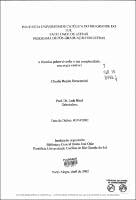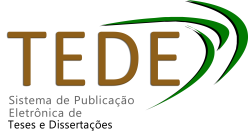| Share record |


|
Please use this identifier to cite or link to this item:
https://tede2.pucrs.br/tede2/handle/tede/11736| Document type: | Tese |
| Title: | A fricativa palato-alveolar e sua complexidade : uma regra variável |
| Author: | Brescancini, Cláudia Regina  |
| Advisor: | Bisol, Leda |
| Abstract (native): | Esta pesquisa tem por objetivo examinar as fricativas palato-alveolares [S, 3], sob a perspectiva da Geometria e Traços (CLEMENTS; HUME, 1995) e da Teoria da Variação Lingüística, modelo laboviano. Em língua portuguesa, consoantes fricativas palato-alveolares realizam-se distintivamente em início de palavra e entre vogais. Na posição de coda, essas consoantes surgem como variantes, fruto de um processo de palatalização do /S/ subjacente. À, luz da primeira perspectiva, [S, 31] são representadas como segmentos complexos corono-dorsais. Propomos ainda que o traço indicativo de palatalização ([+P]) não é o mesmo para consoantes palato-alveolares e palatais: enquanto para [?,?] [+P]equivale ao nó vocálico e seus dependentes Ponto-V [coronal] e abertura, para [S,3],[+P] equivale a [dorsal], dependente de Ponto-V. À luz da segunda perspectiva, procuramos identificar os contextos lingüísticos e sociais, que condicionam sincronicamente a aplicação do fenômeno. A amostra utilizada parte do Banco de Dados do Projeto VARSUL - abrange três regiões do município de Florianópolis, Santa Catarina: centro urbano, Ribeirão da Ilha e Barra da Lagoa. |
| Abstract (english): | This thesis aims at studying the palato-alveolar fricatives [S, 3] under the perspective of Feature Geometry (CLEMENTS; HUME, 1995) and under the perspective of Linguistic Variation Theory, Labovian model. In Portuguese language these consonants are realized distinctively at the beginning of the word and between vowels. In coda position, however, palato-alveolar consonants arise as variants, consequence of the palatalization process of an underlying /S. Under the first perspective, [S, 3] are represented as corono-dorsal complex segments. We propose further that the feature referring to palatalization ([+P]) is not the same to palato-alveolar consonants and palatal consonantas: while [ +P] is equivalent to the Vocalic Node and its dependents P-V [coronal] and Aperture to [?, ?], it is equivalent to the Vocalic Node and its dependent P-V [dorsal] to [S, 3]. Under the second perspective, we tried to detect the linguistic and social contexts that regulate the phenomenon application sincronically. The corpus of the study - part of VARSUL Bank Data - embrace three regions of Florianópolis, Santa Catarina: the downtown area, Ribeirão da Ilha and Barra da Lagoa. |
| Keywords: | Linguística Portuguesa Português - Fonologia Fonologia - Geometria de Traços Variação (Linguística) |
| CNPQ Knowledge Areas: | LINGUISTICA, LETRAS E ARTES::LETRAS |
| Language: | por |
| Country: | Brasil |
| Publisher: | Pontifícia Universidade Católica do Rio Grande do Sul |
| Institution Acronym: | PUCRS |
| Department: | Escola de Humanidades |
| Program: | Programa de Pós-Graduação em Letras |
| Access type: | Acesso Aberto |
| Fulltext access restriction: | Trabalho não apresenta restrição para publicação |
| URI: | https://tede2.pucrs.br/tede2/handle/tede/11736 |
| Issue Date: | 3-Apr-2002 |
| Appears in Collections: | Programa de Pós-Graduação em Letras |
Files in This Item:
| File | Description | Size | Format | |
|---|---|---|---|---|
| TES_CLAUDIA_REGINA_BRESCANCINI_COMPLETO.pdf | CLAUDIA_REGINA_BRESCANCINI_TES | 21.78 MB | Adobe PDF |  Download/Open Preview |
Items in DSpace are protected by copyright, with all rights reserved, unless otherwise indicated.




